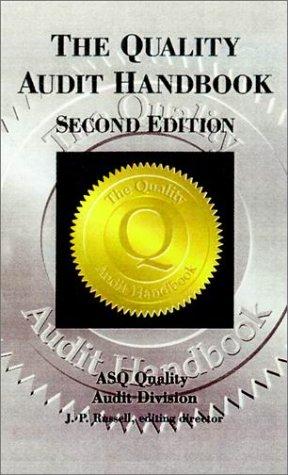Question
The unadjusted trial balance of the Manufacturing Equitable at December 31, 2013, the end of its fiscal year, included the following account balances. Manufacturings 2013
The unadjusted trial balance of the Manufacturing Equitable at December 31, 2013, the end of its fiscal year, included the following account balances. Manufacturings 2013 financial statements were issued on April 1, 2014.
| Accounts receivable | $ | 99,000 | |
| Accounts payable | 35,400 | ||
| Bank notes payable | 698,000 | ||
| Mortgage note payable | 1,315,000 | ||
| Other information: | |
| a. | The bank notes, issued August 1, 2013, are due on July 31, 2014, and pay interest at a rate of 12%, payable at maturity. |
| b. | The mortgage note is due on March 1, 2014. Interest at 11% has been paid up to December 31 (assume 11% is a realistic rate). Manufacturing intended at December 31, 2013, to refinance the note on its due date with a new 10-year mortgage note. In fact, on March 1, Manufacturing paid $297,000 in cash on the principal balance and refinanced the remaining $1,018,000. |
| c. | Included in the accounts receivable balance at December 31, 2013, were two subsidiary accounts that had been overpaid and had credit balances totaling $18,650. The accounts were of two major customers who were expected to order more merchandise from Manufacturing and apply the overpayments to those future purchases. |
| d. | On November 1, 2013, Manufacturing rented a portion of its factory to a tenant for $36,000 per year, payable in advance. The payment for the 12 months ended October 31, 2014, was received as required and was credited to rent revenue. |
| Required: |
| 1. | Prepare any necessary adjusting journal entries at December 31, 2013, pertaining to each item of other information (ad). (Leave no cells blank. If no entry is required, select "No journal entry required" in the account field and enter zero (0) in the amount field. Do not round intermediate calculations.) |
| General Journal | Debit | Credit | |
| a. | (Click to select)Accounts receivableUnearned rent revenueInterest payableNo journal entry requiredAdvances from customersRent revenueCashInterest expense | ||
| (Click to select)Rent revenueUnearned rent revenueCashAdvances from customersAccounts receivableInterest payableInterest expense No journal entry required | |||
| b. | (Click to select)Unearned rent revenueInterest expenseCashNo journal entry requiredAdvances from customersRent revenueAccounts receivableInterest payable | ||
| (Click to select)No journal entry requiredUnearned rent revenueAdvances from customersRent revenueInterest expenseAccounts receivableCashInterest payable | |||
| c. | (Click to select)Unearned rent revenueCashInterest expenseAdvances from customersAccounts receivableNo journal entry requiredRent revenueInterest payable | ||
| (Click to select)Interest expenseInterest payableCashRent revenueNo journal entry requiredAdvances from customersAccounts receivableUnearned rent revenue | |||
| d. | (Click to select)Unearned rent revenueAccounts receivableInterest payableAdvances from customersNo journal entry requiredRent revenueInterest expenseCash | ||
| (Click to select)Rent revenueNo journal entry requiredAdvances from customersCashInterest expenseAccounts receivableInterest revenueUnearned rent revenue | |||
| 2. | Prepare the current and long-term liability sections of the December 31, 2013, balance sheet. (Do not round intermediate calculations.) |
| Balance Sheet At December 31, 2013 | |
| Current liabilities: | |
| (Click to select)Bank notes payableAccrued interest payableUnearned rent revenueAdvances from customersCashMortgage note payableCurrent portion of long-term debtAccounts payable | $ |
| (Click to select)Accounts payableUnearned rent revenueAccrued interest payableMortgage note payableCashBank notes payableCurrent portion of long-term debtAdvances from customers | |
| (Click to select)CashAccrued interest payableAdvances from customersMortgage note payableAccounts payableBank notes payableCurrent portion of long-term debtUnearned rent revenue | |
| (Click to select)Current portion of long-term debtMortgage note payableCashUnearned rent revenueBank notes payableAccrued interest payableAccounts payableAdvances from customers | |
| (Click to select)CashAccrued interest payableAdvances from customersBank notes payableMortgage note payableUnearned rent revenueAccounts payableCurrent portion of long-term debt | |
| (Click to select)Accrued interest payableUnearned rent revenueCurrent portion of long-term debtAdvances from customersBank notes payableAccounts payableCashMortgage note payable | |
| Total current liabilities | $ |
| Long-term liabilities | |
| (Click to select)Mortgage note payableCurrent portion of long-term debtBank notes payableAccounts payableAccrued interest payableUnearned rent revenueCashAdvances from customers | $ |
Step by Step Solution
There are 3 Steps involved in it
Step: 1

Get Instant Access to Expert-Tailored Solutions
See step-by-step solutions with expert insights and AI powered tools for academic success
Step: 2

Step: 3

Ace Your Homework with AI
Get the answers you need in no time with our AI-driven, step-by-step assistance
Get Started


